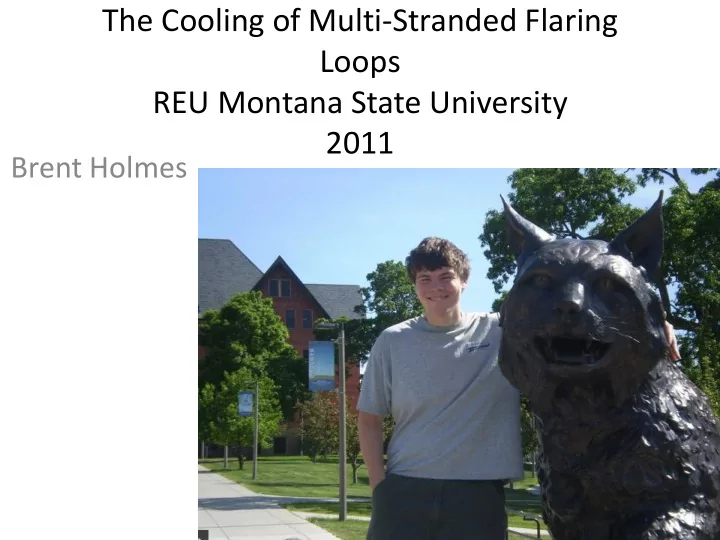

The Cooling of Multi-Stranded Flaring Loops REU Montana State University 2011 Brent Holmes
Yohkoh SXT • I am using data from the Soft X- ray Telescope aboard Yohkoh
Solar Flare
Searching for a better model for the cooling of solar flares • Current theories cannot model the cooling very well. We will be working to better fit the tails of these light curves by varying parameters including number of loops.
With better resolution, we can see more loops than were initially visible. • SXT TRACE • We believe there are more loops then seen even here that would be visible with even better resolution.
How Could There Be Many Loops and Yet We Don’t See Them?
A saturated frame and a normal frame • When I had retrieved the data from Yohkoh for our project, I had to remove saturated frames like the one below. I also had to remove frames not focused on the flare, scattered light and vignetting.
1992 September 6 Flare Before • This movie shows what the data looked like before I cleaned it up.
1992, September 6 Flare After • This movie shows the data after I cleaned it up.
Selected Pixels • You can see where I picked the pixels to make light curves from.
Selected Pixels • Here’s another view from the movie program we used to help us follow where the pixels were in the flare.
Light Curve 1992 September 6 Filter 2
Light Curve 1992 September 6 Filter 4
Light Curve 1992 September 6 Filter 5
Light Curve Stitching Before • The align program wasn’t working properly.
Light Curve Stitching After • So I made a program to let me repick the pixels to make the light curves after the jumps.
Loop Length vs Time 1992 September 6 • With this best fit line we are able to give input of loop length change to our program.
Why Does Loop Length Increase? • Flare strands form on top of older strands. So like this rainbow as you go up the length and foot point distance increases
How much do the footpoints move? • The x’s mark the position at 5:14:32. • The o’s mark the position at 5:24:02.
cm per arcsecond on different parts of the sun • Observing different parts of the sun gives different distances for the same angles, because we are making a 3D object 2D
Hard X ray 1992 September 6th • The contours are the hard x-rays, the colored parts are the soft x-rays
Finding the Best Temperature, Density, and Number of Strands • This is a picture of the running amoeba program
What is an amoeba?
The Amoeba’s Flow Chart (courtesy C.C. Kankelborg)
Amoeba • Amoeba searches for the best fit line. In this early picture it is far off
Amoeba
Amoeba
Amoeba
Amoeba
Amoeba • Eventually it finds a pretty good fit.
Best fit results to flare of September 23, 1998
Comparison New to Old
Amoeba Loop number vs peak temperature
Comparison Ours to Single Strand Model
Single Strand Can Be Close but the Parameters Become Unreasonable
Best fit results to flare of December 27 th , 1999
Comparison New to Old
Comparison Ours to Single Strand Model
Single Strand Can Be Close but the Parameters Become Unreasonable
The Future • We have successfully improved our model so that it better fits the cooling of solar flare loops. In the future, we hope to improve our bounds on parameter space so that our fits can be even better and our model can be physically accurate.
Recommend
More recommend